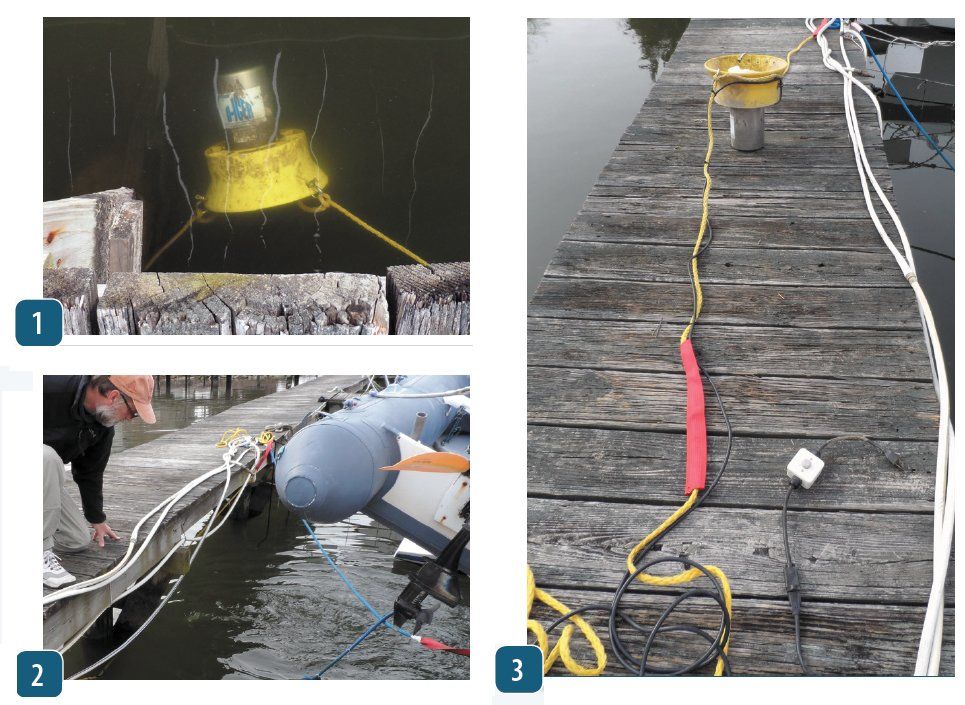When it comes to deicers, proper installation is key. Here are some tips to ensure your setup will optimize ice removal.

The deicer should be located on the deeper end of the slip. For slips along long piers, the dock end is simpler. This makes it easier to take the boat out without moving the deicer, and it works just as well. If the boat is alongside a creek or canal, the outboard end is preferred.
An angled deicer works better than a perpendicular one. Ideally, it should be angled about 45 degrees to pull water up and to one side. Because of dynamic effects when the unit is turned on, this only requires offsetting the suspending lines by about 1 inches. Adjust the lines according to the flow pattern required.
If ice pressure from in front of the dock is your biggest concern, the deicer can be oriented vertically. Although you wont want to enter the water in the winter, be prepared to make minor aiming adjustments to optimize ice removal.
The power cable must be attached to one of the suspension lines every few feet. If loose, it can tangle in the prop.
Replace the cheap polypropylene suspension lines that come with the unit with 3/8-inch polyester or nylon line. The most common failure in deicers is a broken suspension line. When a line fails, the deicer drops to the bottom, and a stone or shell can wear through the can, allowing seawater to enter the motor.
Suspension lines must be set at angles at least 120 degrees apart. The start-up torque can wind the ropes together and damage the cord, if the angle is too narrow. This is doubly important if there is any current, which can push lines into the propeller while it is turned off during the day.
Be sure to install good chafe gear. The mixer vibrates continuously when in operation. Hose or tubular nylon webbing work well.
You can attach the deicer either to the boat or the piers. However, it should not touch the bottom, if the mixer stops or if the tide drops. It must not become exposed, if the tide drops.
A thermostat is required to save both energy and wear. There is no need for the mixer to run until the temperature is substantially below freezing (about 25 degrees), often only at night.
All connections, as well as the thermostat, must be protected from precipitation. An overturned five-gallon bucket works well.
Diffuser installation
With appropriate hose, a diffuser can be located some distance from the water. Make certain it is above the flood line. Though a cabinet is not strictly required, weather protection will greatly increase a units life expectancy.
The hoses must run consistently downhill. Hoses that run uphill will fill with condensed water and freeze, probably for the rest of the winter. Burying lines below the frost line helps, but always maintain downward slope and insulate all exposed runs with foam tubing. Run the lines under water rather than suspending from the dock. The hoses should be insulated beyond the waterline, well below the low-tide mark.
Test the unit in warmer weather. In areas with soft bottoms, you may have to place a metal plate to support the unit; however, a large plate can become imbedded in the bottom, impossible to recover in the spring. Try it in summer first, without any additional support.
The required size will vary with the salinity of the water, climate, tidal flushing, location of the slip within the marina, and the size of the boat. We suggest asking local sailors and deicer manufacturers what size is recommended. In general, a 0.5-horsepower will handle most boats in brackish or sea water, and a 0.75-horsepower unit may be required in very cold climates in fresh water and for larger boats.
Check the operation of the deicer at least every two weeks. Look for even water flow and no bouncing. If the flow is diminished or the ropes are bouncing more than normal, either a blade is broken or something is caught in the propeller. With compressor types, look for even bubble flow and open water. Air filters can clog, and hoses can freeze.








































